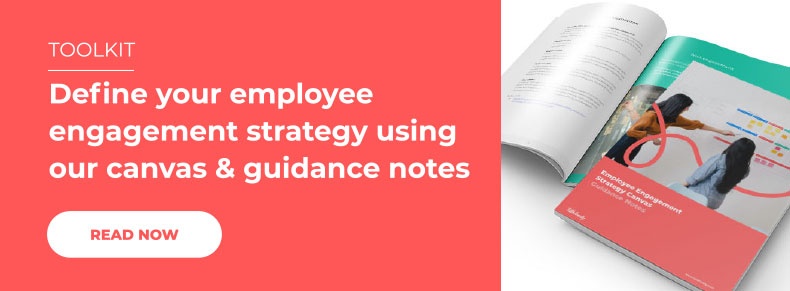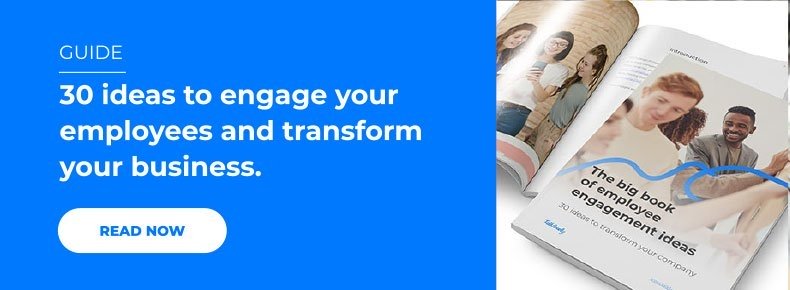How is your employee engagement program holding up? With the world of work changing beyond recognition over the last few years, it will probably need a bit more than a simple refresh. All too often, companies take a set-it-and-forget-it approach to their employee engagement programmes. What worked last year is bound to be fine this year, yes? Well, no. With the sudden shift to hybrid working, the increasing dissatisfaction with work-life boundaries and complex communication issues, one thing is certain – your employee engagement programme needs a major rethink.
In this blog, we take a closer look at why focusing on your long-term employee engagement planning is so important. We explore the fundamental changes that have taken place in the workplace in recent times. How can we include these shifts in our updated employee engagement programs? And what questions do we need to ask to ensure our employee engagement strategies will be successful?
Why you need an employee engagement program
Do you really need to put in all that effort to draw up an employee engagement programme? The short answer is ‘yes’. A successful plan will help you to clearly define your business goals in communicating with employees. And it will go on to set out the various activities required to achieve these goals. Look at it as the blueprint that will lead you towards improved employee engagement and motivation.
The benefits of employee engagement are far-reaching and profound. Successful employee engagement programs will guarantee an immediate uplift in staff loyalty, motivation and productivity. Plus, with the threat of the ‘big resignation’ looming large, you’ll find that retention levels begin to improve.
Or you can look at it another way. Without a solid employee engagement programme in place, your company will struggle to succeed. Poor communication and engagement can have an extremely negative effect on your business. It leads to lowered morale, reduced productivity and ultimately reduced profits. Research by Towers Watson revealed that companies that communicate ineffectively are 50% more likely to report below-average turnover levels. In short, it will seriously affect your bottom line.
How the world of work has changed (& how it affects employee engagement programs)
The last couple of years has had a significant impact on the world of work. Business leaders need to evaluate the immediate and longer-term effects of these changes and adjust their strategies to suit.
- Hybrid working: It’s here to stay, and we need to adjust our employee engagement model A recent study by Gartner revealed that if an organisation were to return to a completely on-site arrangement, it would risk losing up to 39% of its workforce. We need to create a new human-centric model for the hybrid environment.
- Talent shortage: Where are all the skilled workers? It’s becoming increasingly difficult to fill those roles requiring critical skills. To fill these skills needs, we need to facilitate the mobility of employees within the organisation. And that requires good communication, and maximum work engagement.
- Well-being focus: It’s the new priority for both employers and employees, and we need to adjust our employee engagement activities Gartner suggests that 70% of organisations made additional investments in well-being throughout the last two years, and there’s more work to be done.
- DE&I issues: The impact of hybrid and remote working can negatively impact diversity, equality and inclusion issues. On-site employees are more likely to be promoted, and women and employees from underrepresented groups often take up the flexible hybrid work options. We need to support all employees in this hybrid environment.
- Management roles: The traditional role of the manager is changing. With reduced opportunities for in-person interactions, we need to explore how managers can build successful relationships with their teams. The best employee engagement programs will provide additional tools for managers to assist them in this transition.
Employee engagement programmes: Five questions to ask
Before you start building your strategy, take a step back and ask yourself these five key questions. You’ll find that the answers will help to lay the foundation of your employee engagement program and set you up for success.
Question #1: What is your overall goal?
You need to tie down your end goal to get the most out of your employee engagement initiatives. You need to define what value you are planning to add via your employee engagement programme. This will be different for every organisation. Some businesses will focus on staff retention; others will aim to increase productivity. You may be trying to boost management relationships or improve your DE&I outcomes.
You may need to work through ideas with different stakeholders until you agree on a common goal and a core target. This is definitely a stage that shouldn’t be handled by one person alone. Ultimately, unless you can nail down what you want to change as a result of your employee engagement program, you’ll struggle to make it effective.
Question #2: Who is your programme aimed at?
Know your audience. It’s at the core of every business strategy, from marketing to sales. And it applies to your employee engagement model as well. Your employees are under more time pressure than ever before, and it’s your job to understand their issues, cut through the noise and make sure your message gets heard.
Segmentation is the route to success. It will enable you to understand your audience and what information they will find relevant and interesting. For example, employees of different ages will prefer different styles and channels of communication. Hybrid and remote workers will be harder to connect with than office-based employees and require alternative channels. Attitude is another segment to consider. Those feeling demotivated may require a different approach than those actively engaged.
An excellent way to cover all the bases is to implement an employee engagement platform. It will enable you to use a variety of channels, approaches and techniques to ensure you are reaching every sector of your audience. One thing is for sure; there is no one-size-fits-all approach to employee engagement programmes.
Question #3: Why should they care?
When exploring how to engage employees, you need to factor in the “why should I care?” question. Remember, although your messages will be a priority to you, they won’t be to the majority of employees. Your workers will see everything you are saying through their own personal prism. They’ll wonder if their job is secure if they’ll have to change how they work and whether your message is important enough to act upon.
The best employee engagement programs will incorporate the Know-Feel-Do approach. This involves asking what your audience needs to know to take action, what they need to feel to act, and what you want them to do as a result of your communication. This three-step strategy will help you to delve deeper into crafting truly effective engagement messages.
Question #4: What is your schedule?
Consistency is key. Successful employee engagement programs maintain a regular schedule of communications. You’re looking to keep up a regular, scheduled and consistent pace of messaging. This will help to create a sense of belonging amongst your staff. Engagement levels will start to dip when communications become intermittent as employees feel side-lined and forgotten. This is especially relevant for hybrid workers, who are prone to falling out of the loop of regular communications.
Timing is crucial as well. You must ensure your communications don’t clash with significant events already on the corporate calendar. Timing is also critical if you’re faced with announcing difficult news such as job losses or management changes. You need to tread that fine line between telling the news too early before you know all the details, and leaving it too late, which will allow rumours to spread.
A simple way to keep your messaging on schedule is to implement an employee engagement app. The in-built scheduling will help you plan timely communications and deliver a steady stream of news without the need for calendars and planners.
Question #5: Which channels are you using?
How a message is delivered is as important as the message itself. And when it comes to communication channels, there are many options to choose from. The traditional email is no longer the powerhouse it used to be. Employees receive somewhere between 100 to 120 work emails daily, and it’s clear that any internal communication is at risk of getting lost in the deluge.
When faced with the wide range of communication channels available, you need to consider which one will best engage your employees. Will they respond to an instant notification sent to their smartphone, a social media blast, or perhaps a daily news feed? The best employee engagement programs will provide a choice of channels to allow for a personalised experience for every employee. An employee engagement platform will offer a range of channels within one user-friendly app.
And remember, two-way communication is an essential element of every employee engagement programme. Rather than just delivering information, you need to offer an opportunity for your employees to reply and respond. By providing a platform for the employee voice, you’ll instantly boost engagement levels across the company.









.jpg)
.jpg)